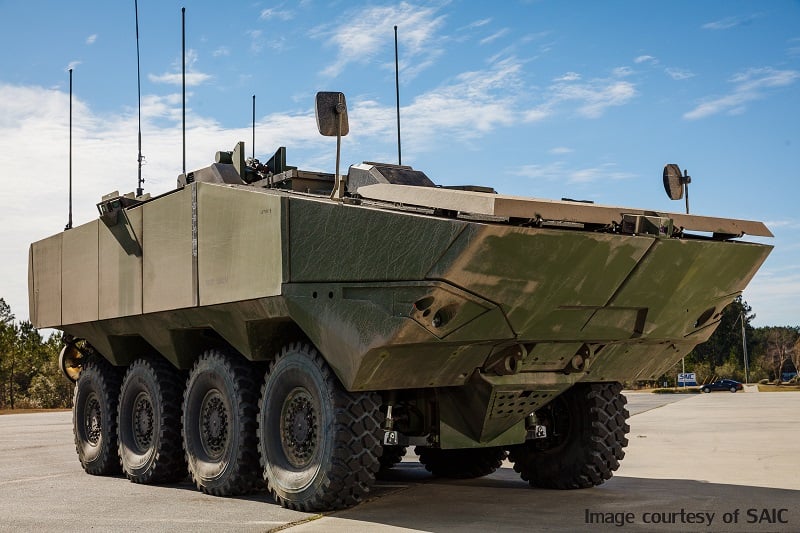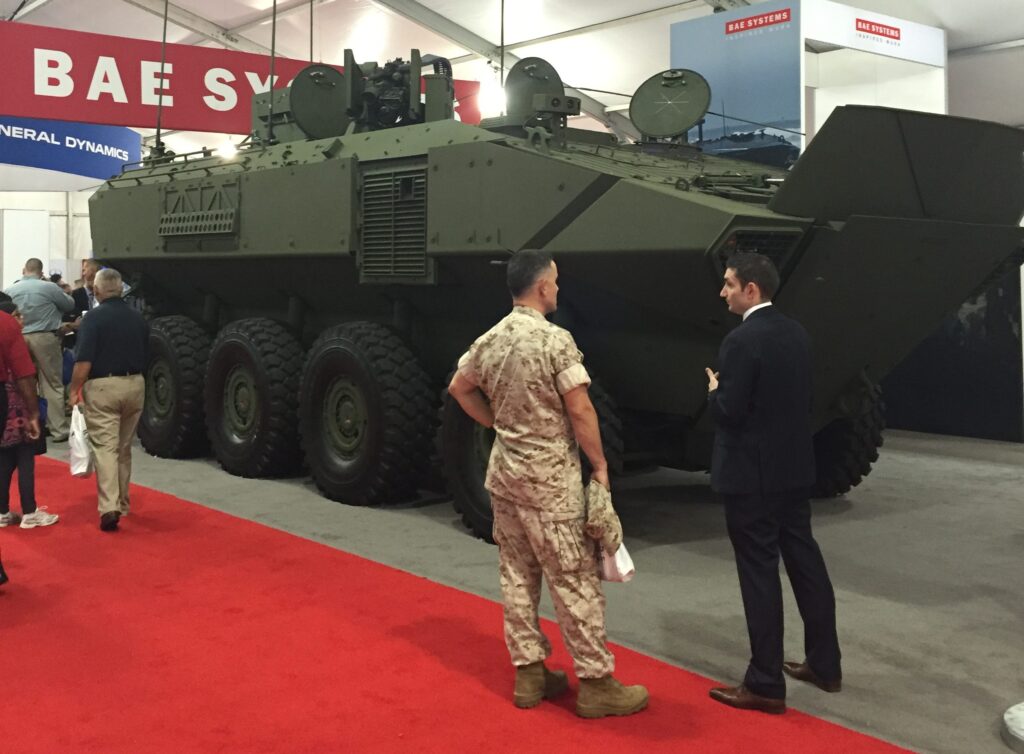GAO Nitpicks Marine Amphibious Combat Vehicle: A 4-Month Delay?
Posted on

Terrex 2, the SAIC / ST Kinetics contender for the Marines’ Amphibious Combat Vehicle.
UPDATED: Adds GAO rebuttal WASHINGTON: The latest GAO report on the Amphibious Combat Vehicle may reveal more problems with GAO’s approach than with the Marine Corps program. While the Government Accountability Office does its usual solid work on the numbers, when it recommends delaying production by four months to do additional testing, it’s acting from an excess of caution that arguably overlooks the fundamental nature of the program. Unlike high-tech weapons systems that have gone unexpectedly awry in testing, the Marines deliberately decided ACV would be a modest upgrade of a proven, traditional design.
Here’s the crucial passage: “We see parallels between the risks facing the ACV program and those faced by the previous amphibious vehicle replacement program—the Expeditionary Fighting Vehicle—that was canceled after more than a decade of effort and the expenditure of $3.7 billion.” The particular problematic parallel, another passage elaborates, is “the concurrency between testing and production,” i.e. that the program doesn’t finish testing the prototypes before it starts building in bulk.
Avoiding such overlap is a sound principle in general. There have been plenty of costly problems in the past with programs that committed to production contracts before they’d finished making sure the weapon worked. (The F-35 Joint Strike Fighter is the biggest example). But in this specific case, GAO is comparing two radically different programs.
The “previous amphibious vehicle replacement program,” the Expeditionary Fighting Vehicle, was an ambitious effort to develop a hybrid of tank and speedboat. EFV was an armored transport for 17 Marines that could not just float, like the traditional amtrac, but skim over the water at 20-25 knots (23-29 mph). Contractor General Dynamics actually got the sea-skimming part to work, but the resulting cost, complexity, and compromises to performance over land — including IED protection — proved too much for the Marines.
So instead the service settled for the Amphibious Combat Vehicle, itself an evolution of an earlier no-frills program with the humble name of Marine Personnel Carrier. ACV will be wheeled, not tracked; it will carry only 11 to 13 Marines, not 17; and, most important, it will only be required to trundle through the water at the seven knots or so, the same as the existing Amphibious Assault Vehicle. These more modest requirements, in turn, mean the ACV will be derived from an existing design, not developed from scratch. Of the two competitors, BAE Systems is offering an upgrade of the Italian SuperAv, also bought by Brazil, while SAIC is offering an upgrade of the Singaporean military’s Terrex.

BAE Systems proposal for the Amphibious Combat Vehicle, derived from the Italian IVECO SuperAV
While the ACV designs aren’t identical to vehicles in foreign service, they’re modifications of existing machines that require far less testing than an all-new design built to the same requirements — let alone an all-new design that’s trying to do technical feats previously deemed impossible, like EFV. For GAO to equate EFV and ACV is a bit like comparing ostriches to sparrows: Sure, they’re both birds, so they both could conceivably have similar problems with their wings, but one of them weighs about 3,000 times more and cannot fly. (The ostrich is the EFV in this analogy).
The other superficially sensible reason GAO gives for the delay is that a protest to the original R&D contracts — by General Dynamics, incidentally builder of the cancelled EFV — led to stop-work orders that lasted more than three months. That protest delay had knock-on effects throughout the schedule, in particular pushing back the start of developmental testing by two months, from February of this year to April, i.e. this month, “around the time in the budget process that Congress begins deliberating whether to fund the first year of ACV production.” A four-month delay, GAO argues, would not only give more time for testing, it would also push the decision on low-rate initial production into fiscal 2019, given Congress another budget cycle to decide.
Considering that Congress hasn’t passed the 2017 budget yet, it seems naively optimistic to imagine that legislators must have ACV data ASAP if they’re to make a decision for 2018. It’s also a bit naïve to think that a bid protest inevitably delays a program. As a practical matter, most major programs can count on a three-month protest, and a competent program manager will build his schedule to accommodate that delay.
What’s more, as the GAO report itself points out, the Marines have already delayed Milestone C four months, from February 2018 to June. Another delay seems redundant.

The Good & Bad of GAO
The Government Accountability Office does important work. In this report, for instance, GAO points out a misleading apples-to-oranges comparison in a benchmark Pentagon document, the Selected Acquisition Report. The current SAR calculates that the cost to maintain and operate a fleet of 204 new Amphibious Combat Vehicles (the ACVs) over 20 years would be $600 million less than sustaining the current, aging Amphibious Assault Vehicle (AAV) for the same period ($3.5 billion for AAV, $2.9 billion for ACV). But, as GAO rightly notes, the Marines aren’t replacing AAVs with ACVs one for one, because the new vehicle carries fewer troops — 11 to 13 passengers versus the old AAV’s 17 — so you’d need more of them. The Marines themselves told GAO that the 204 ACVs planned for the first phase of production would only replace 180 old AAVs, and even then you’d lose some passenger capacity in the process. The Pentagon has promised to correct the SAR figures.
GAO is great at this kind of significant, meticulous detail. It’s worth noting that GAO originally stood for General Accounting Office, and the number-crunching culture remains dominant. Besides writing reports, GAO’s other chief function is to rule on bid protests claiming a government contract was awarded improperly — a process less about the merits of the product than about strict application of formal rules.
When the GAO turns its sights from regulations and calculations to the big picture, however, it sometimes seems to lose the forest for the trees. Its reports make certain general-purpose recommendations over and over again — develop a business case, improve processes, increase efficiency, do more study, delay the program — without necessarily looking at whether they’re impractical or productive in the particular case at hand. A senior GAO manager admitted as much to Congress when challenged about a recommendation to pause production of the Navy’s Littoral Combat Ship. Sometimes GAO’s fixation on measuring every program against a single, idealized template can lose track of what makes a specific program work.

UPDATED: GAO’s Rebuttal
“The article that you put out was a little bit unfair,” said Marie Mak, a director in the acquisition division at GAO, in an urgently arranged call this afternoon. “There’s a reason for the four months (delay). That is valid, that’s not being nitpicky.”
“Four months…it’s not going to derail the program,” Mak told me, but it will give time to get “critical” testing done before Congress has to commit to funding procurement. In particular, GAO is worried about so-called reliability growth testing, which tries to improve the reliability of a system over time.
Is that so critical, I asked, for something like the Amphibious Combat Vehicle, where both competitors are offering upgrades of existing designs that already have a real-world track record of reliability? “I would counter that design is not ‘traditional,’ not ‘off the shelf,’ but I would not go into detail because that’s sensitive information,” Mak replied. There are components on both ACV competitors that are not just minor modifications of off-the-shelf systems and which will require significant testing, she explained, but because the competition is ongoing, GAO can’t legally discuss them with the press.
Regardless of what those details might be, GAO wants at least the reliability growth testing done before Congress has to vote on procurement. “One of the things we’ve always argued about (programs in general) is, if Congress funds it, their other tools of oversight are fairly weak.” Mak said. Often, “if Congress pays the money up front (and then) it gets messed up in testing… it’s not like they’re able to do anything at that point.”
Subscribe to our newsletter
Promotions, new products and sales. Directly to your inbox.
